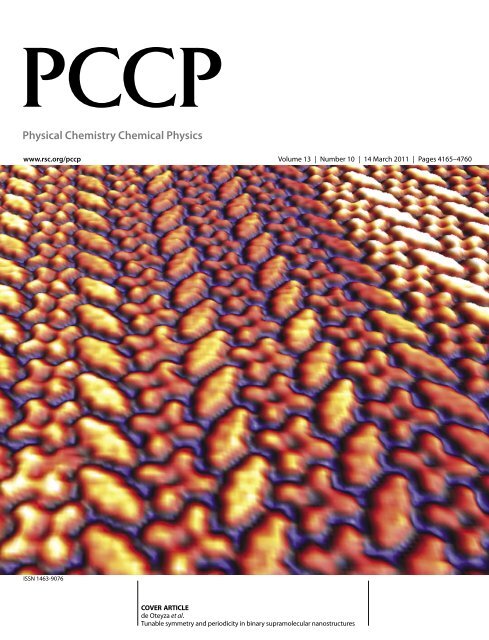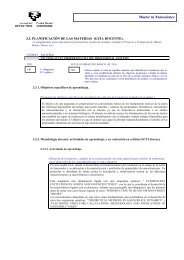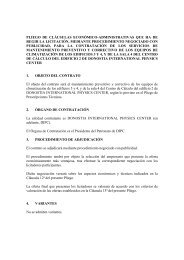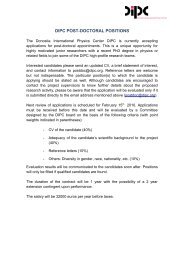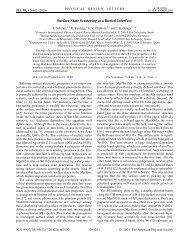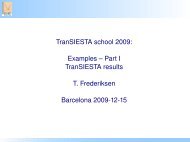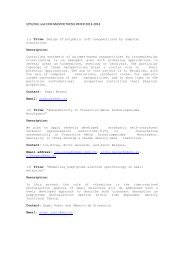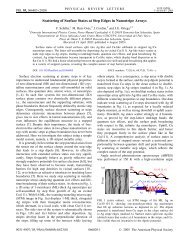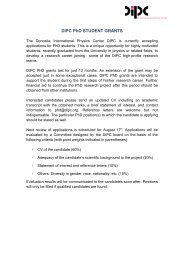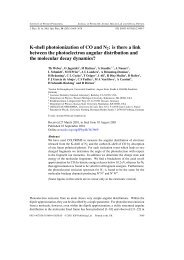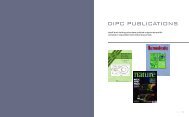Tunable symmetry and periodicity in binary supramolecular ...
Tunable symmetry and periodicity in binary supramolecular ...
Tunable symmetry and periodicity in binary supramolecular ...
You also want an ePaper? Increase the reach of your titles
YUMPU automatically turns print PDFs into web optimized ePapers that Google loves.
Physical Chemistry Chemical Physics<br />
www.rsc.org/pccp Volume 13 | Number 10 | 14 March 2011 | Pages 4165–4760<br />
ISSN 1463-9076<br />
COVER ARTICLE<br />
de Oteyza et al.<br />
<strong>Tunable</strong> <strong>symmetry</strong> <strong>and</strong> <strong>periodicity</strong> <strong>in</strong> b<strong>in</strong>ary <strong>supramolecular</strong> nanostructures
PCCP<br />
Dynamic Article L<strong>in</strong>ks<br />
Cite this: Phys. Chem. Chem. Phys., 2011, 13, 4220–4223<br />
www.rsc.org/pccp<br />
COMMUNICATION<br />
<strong>Tunable</strong> <strong>symmetry</strong> <strong>and</strong> <strong>periodicity</strong> <strong>in</strong> b<strong>in</strong>ary <strong>supramolecular</strong><br />
nanostructuresw<br />
Downloaded on 04 March 2011<br />
Published on 01 February 2011 on http://pubs.rsc.org | doi:10.1039/C0CP02388D<br />
Dimas G. de Oteyza,z* ab Esther Barrena, cd Helmut Dosch, e J. Enrique Ortega fg <strong>and</strong><br />
Yutaka Wakayama b<br />
Received 3rd November 2010, Accepted 7th January 2011<br />
DOI: 10.1039/c0cp02388d<br />
We present a route to change the ‘‘compositional’’ order of<br />
highly crystall<strong>in</strong>e b<strong>in</strong>ary layers compris<strong>in</strong>g di<strong>in</strong>denoperylene <strong>and</strong><br />
copper-phthalocyan<strong>in</strong>es from two- to one-dimensional <strong>periodicity</strong>.<br />
This is achieved by exchang<strong>in</strong>g fluor<strong>in</strong>e with hydrogen atoms <strong>in</strong><br />
the phthalocyan<strong>in</strong>es, thereby reduc<strong>in</strong>g the C–FH–C <strong>in</strong>teractions<br />
<strong>and</strong> allow<strong>in</strong>g the <strong>in</strong>terplay of long-range electrostatic<br />
<strong>in</strong>teractions <strong>in</strong> mesoscopic phases. L<strong>in</strong>ear patterns are thus<br />
obta<strong>in</strong>ed, whose <strong>periodicity</strong> can be additionally tuned by an<br />
appropriate stoichiometry of the components.<br />
Molecular electronics is envisioned as one of the possible breakthroughs<br />
<strong>in</strong> electronics <strong>and</strong> <strong>in</strong>formation technology. Progress <strong>in</strong><br />
the control of <strong>supramolecular</strong> self-assembly is expected to<br />
make it possible, pav<strong>in</strong>g the way towards tailored synthesis of<br />
functional molecular nanostructures. However, the assembly of<br />
appropriate molecules <strong>in</strong>to well ordered arrays on technologically<br />
relevant surfaces is a challenge that dem<strong>and</strong>s the<br />
control of system <strong>in</strong>teractions at different length scales. At the<br />
nanoscopic level, the process is determ<strong>in</strong>ed by a complex <strong>in</strong>terplay<br />
between <strong>in</strong>termolecular <strong>and</strong> molecule–substrate <strong>in</strong>teractions.<br />
Several routes have been exploited to steer those <strong>in</strong>teractions. A<br />
h<strong>and</strong>le on molecule–substrate <strong>in</strong>teractions is provided by the<br />
use of nanostructured surfaces. This has been demonstrated<br />
with surface superstructures or stepped surfaces, which can, for<br />
example, def<strong>in</strong>e preferential adsorption sites. 1–5 In turn, the use<br />
of appropriate molecules with complementary functional<br />
a Donostia International Physics Center, Paseo Manuel Lardizabal 4,<br />
20018 San Sebastia´n, Spa<strong>in</strong><br />
b Advanced Electronic Materials Center, National Institute for<br />
Materials Science, 1-1 Namiki, Tsukuba 305-0044, Japan<br />
c Max-Planck Institute for Metal Research, Heisenbergstr. 3,<br />
70569 Stuttgart, Germany<br />
d Institut de Ciencia de Materials de Barcelona, CSIC, Campus UAB,<br />
08193 Bellaterra, Spa<strong>in</strong><br />
e Deutsches Elektronen Synchrotron (DESY), Notkestr. 85,<br />
D-22607 Hamburg, Germany<br />
f Centro de Fı´sica de Materiales (CSIC-UPV/EHU)-Materials<br />
Physics Center (MPC), Paseo Manuel Lardizabal 5,<br />
20018 San Sebastia´n, Spa<strong>in</strong><br />
g Departamento de Fıśica Aplicada, Universidad del Pais Vasco,<br />
Pza. On˜ate 2, 20018 San Sebastia´n, Spa<strong>in</strong><br />
w Electronic supplementary <strong>in</strong>formation (ESI) available: Experimental<br />
details, larger scale STM images. See DOI: 10.1039/c0cp02388d<br />
z Current address: Lawrence Berkeley National Laboratory, Molecular<br />
Foundry, 1 Cyclotron Road, Berkeley, CA 94720, USA. E-mail:<br />
dgoteyza@lbl.gov; Tel: +1 510 4952074.<br />
groups allows the formation of strong <strong>in</strong>termolecular <strong>in</strong>teractions.<br />
These <strong>in</strong>clude hydrogen bonds, 5–10 or even chemical<br />
reactions, 11,12 both of whose directionality provides an additional<br />
control parameter <strong>in</strong> the design of molecular arrays.<br />
Ideally, long-range ordered molecular arrays with tunable<br />
<strong>symmetry</strong> <strong>and</strong> <strong>periodicity</strong> are desired. A beautiful example<br />
thereof recently reported are molecular grat<strong>in</strong>gs made of<br />
methion<strong>in</strong>e stripes on silver surfaces, 13 which have been used<br />
as templates for the subsequent growth of atomic str<strong>in</strong>gs. 14<br />
Their tunable <strong>periodicity</strong> (via methion<strong>in</strong>e coverage), together<br />
with their behavior as one-dimensional electron resonators,<br />
allows tailor<strong>in</strong>g the characteristics of quantum-well states. 15<br />
Supramolecular self-assembly of two- (or multi-) component<br />
systems has been repeatedly used for successful synthesis of<br />
highly ordered nanostructured layers with diverse crystall<strong>in</strong>e<br />
structures. Most examples report the formation of well ordered<br />
two-dimensional molecular mixtures. 5–8,16–31 A lesser number<br />
reports the formation of crystall<strong>in</strong>e structures with each of<br />
the molecular components arranged <strong>in</strong> separate rows <strong>and</strong><br />
therefore lead<strong>in</strong>g to the one-dimensional ‘‘compositional’’<br />
order. 28–35 Only few of the aforementioned examples show<br />
tunable properties of their <strong>symmetry</strong> (chang<strong>in</strong>g e.g. between<br />
one- <strong>and</strong> two-dimensional structures) or <strong>periodicity</strong>, which is<br />
achieved either by adjust<strong>in</strong>g the molecular ratio 9,16,25,30,31 or<br />
by anneal<strong>in</strong>g treatments. 26,29,32 In this communication, we<br />
demonstrate the formation of <strong>supramolecular</strong> nanostructures<br />
with tunable properties of both their <strong>symmetry</strong> <strong>and</strong> <strong>periodicity</strong>,<br />
by means of adjustment of the <strong>in</strong>termolecular <strong>in</strong>teractions <strong>and</strong><br />
of the b<strong>in</strong>ary layer stoichiometry of copper-phthalocyan<strong>in</strong>es<br />
<strong>and</strong> di<strong>in</strong>denoperylene (DIP, Fig. 1a).<br />
The complementary functionalities of fluor<strong>in</strong>ated copperphthalocyan<strong>in</strong>es<br />
(F 16 CuPc, Fig. 1a) <strong>and</strong> DIP give rise to rather<br />
strong <strong>in</strong>termolecular <strong>in</strong>teractions via C–HF–C bonds. 36,37<br />
As a consequence, <strong>in</strong> order to maximize them, growth of<br />
b<strong>in</strong>ary layers <strong>in</strong> a 1:1 ratio on Au(111) <strong>and</strong> Cu(111) surfaces<br />
leads to the formation of highly crystall<strong>in</strong>e two-dimensional<br />
structures with the molecules arranged <strong>in</strong> such a way that each<br />
molecule is surrounded by the opposite species (Fig. 1b). 16,36,37<br />
However C–HF–C <strong>in</strong>teractions can be elim<strong>in</strong>ated by<br />
exchang<strong>in</strong>g F 16 CuPc with its homeomorphic non-fluor<strong>in</strong>ated<br />
counterpart CuPc (Fig. 1a), whose comb<strong>in</strong>ation with DIP <strong>in</strong><br />
b<strong>in</strong>ary layers is therefore expected to present a much lower 2D<br />
cohesive energy.<br />
4220 Phys. Chem. Chem. Phys., 2011, 13, 4220–4223 This journal is c the Owner Societies 2011
Downloaded on 04 March 2011<br />
Published on 01 February 2011 on http://pubs.rsc.org | doi:10.1039/C0CP02388D<br />
Fig. 1 (a) Schematic representation of F 16 CuPc, DIP <strong>and</strong> CuPc<br />
molecules. (b) 12 12 nm 2 STM image of a b<strong>in</strong>ary layer comb<strong>in</strong><strong>in</strong>g<br />
DIP with F 16 CuPc on Au(111) <strong>in</strong> a 1 : 1 ratio. (c) The same as<br />
(b) comb<strong>in</strong><strong>in</strong>g DIP with CuPc.<br />
Our results show that <strong>in</strong>deed, <strong>in</strong> DIP–CuPc b<strong>in</strong>ary layers,<br />
the molecules do not surround themselves by the opposite<br />
species. In contrast, they arrange <strong>in</strong>to alternat<strong>in</strong>g molecular<br />
rows, f<strong>in</strong>ally produc<strong>in</strong>g well ordered layers with one-dimensional<br />
compositional <strong>periodicity</strong> (Fig. 1c) <strong>and</strong> doma<strong>in</strong>s of up to<br />
several tens of nanometres (Fig. S1, ESIw).<br />
Such f<strong>in</strong>d<strong>in</strong>gs apply to different substrates, demonstrated<br />
here with Au(111) <strong>and</strong> Cu(111). Fig. 2 shows small scale STM<br />
images of 1 : 1 b<strong>in</strong>ary layers on both substrates. The similarity<br />
among the structures obta<strong>in</strong>ed on either surface is evident, <strong>and</strong><br />
the ma<strong>in</strong> difference is related to their <strong>symmetry</strong>.<br />
In the case of Au(111) we f<strong>in</strong>d two different molecular<br />
orientations with<strong>in</strong> the rows of each molecular species. The<br />
two azimuthal orientations of each molecule are related by a<br />
mirror plane directed along the molecular rows, evidenc<strong>in</strong>g<br />
their alignment with the high <strong>symmetry</strong> directions of the substrate.<br />
In particular, the rows have been found to align along the Au<br />
[1 10] <strong>and</strong> equivalent directions, giv<strong>in</strong>g rise to three discrete<br />
row orientations separated by 601, each of them additionally<br />
display<strong>in</strong>g two equivalent mirror doma<strong>in</strong>s. The frequent<br />
changes <strong>in</strong> molecular orientation associated with the two mirror<br />
doma<strong>in</strong>s <strong>in</strong>dicate the low energy associated with such doma<strong>in</strong><br />
boundaries.<br />
In contrast, on Cu(111) DIP <strong>and</strong> CuPc molecules present a<br />
s<strong>in</strong>gle orientation for each direction of the molecular rows,<br />
<strong>and</strong> we f<strong>in</strong>d six different directions related by 301 rotations.<br />
This is the result of the molecular rows be<strong>in</strong>g directed 151 off<br />
the high <strong>symmetry</strong> directions (Fig. 2), which leads to the<br />
Fig. 2 10 10 nm 2 STM images of the CuPc : DIP 1 : 1 crystall<strong>in</strong>e<br />
structures on Au(111) <strong>and</strong> Cu(111) surfaces (top) together with the<br />
correspond<strong>in</strong>g epitaxial models (bottom). For the model on Au(111),<br />
the herr<strong>in</strong>gbone reconstruction has been neglected <strong>in</strong> spite of its<br />
experimental observation. Consequently, lattice mismatches of up to<br />
4% may occur <strong>in</strong> dependence of the reconstruction doma<strong>in</strong> orientation.<br />
The <strong>in</strong>clusion of such effect <strong>in</strong>to the model is h<strong>in</strong>dered by the<br />
extension of the molecular doma<strong>in</strong>s throughout multiple rotational<br />
doma<strong>in</strong>s of the substrate reconstruction.<br />
presence of three rotational <strong>and</strong> three mirror doma<strong>in</strong>s alternat<strong>in</strong>g<br />
<strong>and</strong> equidistant by 301.<br />
The parameters of the unit cells outl<strong>in</strong>ed <strong>in</strong> Fig. 2, which<br />
comprise one CuPc <strong>and</strong> one DIP molecule, are given <strong>in</strong> Table 1<br />
for both substrates, together with the respective molecular orientations<br />
with<strong>in</strong> the cell, w <strong>and</strong> f, which correspond to the angle<br />
between vector b <strong>and</strong> the CuPc diagonal or the long DIP axis,<br />
respectively. Below the STM images <strong>in</strong> Fig. 2, we have plotted<br />
schemes of the proposed molecular arrangement <strong>in</strong> relation to the<br />
substrate surface structure. Based on the experimental <strong>in</strong>put, the<br />
models show the closest match<strong>in</strong>g overstructure compatible with<br />
the highest possible degree of epitaxy (commensurate on Au(111)<br />
<strong>and</strong> co<strong>in</strong>cident on Cu(111)). 38 The structural parameters <strong>and</strong><br />
epitaxial matrix are given <strong>in</strong> Table 1 for comparison with the<br />
experimental data. It can be seen that the proposed epitaxial<br />
structures fit excellently to the experimental data <strong>in</strong> terms of<br />
parameters <strong>and</strong> doma<strong>in</strong> orientations.<br />
Based on the similarity of the overlayers on Au(111) <strong>and</strong><br />
Cu(111), whose error marg<strong>in</strong>s of the unit cell parameters<br />
Table 1<br />
Structural parameters of the 1 : 1 crystall<strong>in</strong>e phases on Au(111) <strong>and</strong> Cu(111) from experiment <strong>and</strong> epitaxial models<br />
a b g w f Matrix<br />
Au(111) Exp. 25.4 0.9 14.3 0.4 83 3 24 4 34 4<br />
<br />
Model 25.1 14.4 83.4 26 33 10 6 a<br />
0 5<br />
Cu(111) Exp. 24.4 1 13.8 0.5 83 3 24 4 33 4<br />
<br />
Model 24.7 13.5 83.8 25 33 11 7<br />
1:5 4:5<br />
a This matrix is only approximate, as deviations aris<strong>in</strong>g due to the surface reconstruction are neglected.<br />
This journal is c the Owner Societies 2011 Phys. Chem. Chem. Phys., 2011, 13, 4220–4223 4221
Downloaded on 04 March 2011<br />
Published on 01 February 2011 on http://pubs.rsc.org | doi:10.1039/C0CP02388D<br />
largely overlap, one s<strong>in</strong>gle structure common to both substrate<br />
surfaces cannot be ruled out. However, such case would<br />
decrease the degree of epitaxy with the substrates at least for<br />
one of the overlayers. A similar l<strong>in</strong>ear CuPc–DIP pattern has<br />
been observed on Ag(111), 39 but for this surface the b<strong>in</strong>ary<br />
mixture F 16 CuPc–DIP rema<strong>in</strong>s unexplored <strong>and</strong> a change from<br />
one- to two-dimensional compositional order by controlled<br />
modification of the <strong>in</strong>termolecular <strong>in</strong>teractions has not yet<br />
been proved.<br />
Such film structures with one-dimensional compositional<br />
<strong>periodicity</strong> can be <strong>in</strong>terpreted as phase separation of DIP <strong>and</strong><br />
CuPc <strong>in</strong>to periodically arranged striped doma<strong>in</strong>s (correspond<strong>in</strong>g<br />
to the molecular rows). We suggest that, <strong>in</strong> competition with<br />
<strong>in</strong>termolecular <strong>in</strong>teractions (<strong>in</strong>clud<strong>in</strong>g steric effects <strong>and</strong> van<br />
der Waals <strong>in</strong>teraction), electrostatic <strong>in</strong>teractions may play<br />
an important role, the latter result<strong>in</strong>g either from <strong>in</strong>tr<strong>in</strong>sic<br />
molecular dipoles or from absorption-<strong>in</strong>duced surface dipoles.<br />
Such surface dipoles are responsible for the commonly observed<br />
work function changes of metal surfaces upon molecular<br />
adsorption <strong>and</strong> may largely vary from molecule to molecule,<br />
be<strong>in</strong>g specific to each molecule–substrate <strong>in</strong>terface. 40 Accord<strong>in</strong>g<br />
to previous works, energy m<strong>in</strong>imization by dipole–dipole<br />
<strong>in</strong>teractions <strong>in</strong> b<strong>in</strong>ary systems (with stoichiometries <strong>in</strong> the<br />
range of those used for the present experiments) leads to<br />
segregation <strong>in</strong>to striped phases. 41,42<br />
Thus, although other aspects such as epitaxial relations with<br />
the substrate may play additional important roles <strong>in</strong> the<br />
result<strong>in</strong>g film structure (as discussed above), it seems plausible<br />
to ascribe a decisive role <strong>in</strong> the l<strong>in</strong>ear molecular arrangements<br />
of these b<strong>in</strong>ary layers to long-range dipole–dipole <strong>in</strong>teractions.<br />
In this context, the shortest possible <strong>periodicity</strong> (alternat<strong>in</strong>g,<br />
s<strong>in</strong>gle molecular rows) po<strong>in</strong>ts to very low phase boundary<br />
energies allow<strong>in</strong>g for maximized dipole–dipole <strong>in</strong>teractions.<br />
However, most important is the fact that a controlled<br />
reduction of the <strong>in</strong>termolecular <strong>in</strong>teractions simply by exchang<strong>in</strong>g<br />
fluor<strong>in</strong>e with hydrogen atoms yields remarkable changes from<br />
two- to one-dimensional periodicities <strong>in</strong> the crystall<strong>in</strong>e<br />
structures.<br />
It is worth not<strong>in</strong>g that a similar attempt was reported on<br />
b<strong>in</strong>ary layers comb<strong>in</strong><strong>in</strong>g nickel-tetraphenylporphyr<strong>in</strong> (NiTPP)<br />
with the fluor<strong>in</strong>ated (F 16 CoPc) <strong>and</strong> non-fluor<strong>in</strong>ated (CoPc)<br />
cobalt-phthalocyan<strong>in</strong>es. 24 However, the experiment failed to<br />
f<strong>in</strong>d a tunability of the crystall<strong>in</strong>e properties of such layers,<br />
given the disordered nature of the NiTTP–CoPc mixture.<br />
The structures obta<strong>in</strong>ed by modify<strong>in</strong>g the CuPc:DIP stoichiometry<br />
on either surface are further summarized <strong>in</strong> Fig. 3. Be<strong>in</strong>g<br />
already published previous works on s<strong>in</strong>gle component CuPc or<br />
DIP on both surfaces, 43–47 we only focus on b<strong>in</strong>ary layers with<br />
molecular ratios of 2 : 1 <strong>and</strong> 1 : 2. Most <strong>in</strong>terest<strong>in</strong>gly, we f<strong>in</strong>d<br />
that the <strong>periodicity</strong> of the one-dimensional structures can be<br />
tuned via the stoichiometry. For the CuPc : DIP 2 : 1 ratio we<br />
f<strong>in</strong>d the follow<strong>in</strong>g. On Au(111) we either observe phase separation<br />
<strong>in</strong>to pure CuPc <strong>and</strong> b<strong>in</strong>ary 1 : 1 regions, or a disordered<br />
mixture (alternat<strong>in</strong>g double, triple, or higher multiplicity CuPc<br />
rows with those of DIP). However, on Cu(111) the b<strong>in</strong>ary layer<br />
keeps an ordered arrangement of alternat<strong>in</strong>g molecular rows,<br />
now featur<strong>in</strong>g double rows for the CuPc. The result is thus a<br />
highly regular l<strong>in</strong>ear pattern comparable to the 1 : 1 structure<br />
but with an <strong>in</strong>creased <strong>periodicity</strong>.<br />
Fig. 3 14 14 nm 2 STM images of the result<strong>in</strong>g structures for b<strong>in</strong>ary<br />
layers comb<strong>in</strong><strong>in</strong>g DIP with CuPc with vary<strong>in</strong>g ratios on Au(111) <strong>and</strong><br />
Cu(111) surfaces. For better resolution <strong>in</strong> the 2 : 1 structure image on<br />
Cu(111), an image of the pure DIP region is shown, <strong>and</strong> we refer to the<br />
1 : 1 structure <strong>in</strong> the b<strong>in</strong>ary regions. Marked with grey l<strong>in</strong>es are those<br />
systems lead<strong>in</strong>g to periodic l<strong>in</strong>ear patterns.<br />
A comparable scenario appears for the 2 : 1 ratio, though <strong>in</strong><br />
this case it is on the Cu(111) where we observe phase separation<br />
<strong>in</strong>to pure DIP <strong>and</strong> b<strong>in</strong>ary regions, both of them highly<br />
ordered. 48 Segregation of pure DIP beyond the 1 : 1 stoichiometry<br />
<strong>and</strong> the absence of disordered mixtures with alternat<strong>in</strong>g<br />
molecular rows of r<strong>and</strong>omly vary<strong>in</strong>g multiplicity po<strong>in</strong>t to the<br />
DIP structure as a particularly low energy phase, which alters<br />
the mesoscopic balance of dipole–dipole <strong>and</strong> phase boundary<br />
energies. In contrast, on Au(111) the one-dimensional compositional<br />
order is ma<strong>in</strong>ta<strong>in</strong>ed. Now it is the DIP which features<br />
double molecular rows alternat<strong>in</strong>g with those of CuPc. The<br />
presence of s<strong>in</strong>gle DIP rows <strong>in</strong> the STM image is related to a<br />
slightly deviated stoichiometry, but the absence of disorder or<br />
phase separated regions po<strong>in</strong>ts to potentially highly periodic<br />
l<strong>in</strong>ear patterns upon a more precise stoichiometric deposition.<br />
The differences <strong>in</strong> the 1D order<strong>in</strong>g for different stoichiometries<br />
of the CuPc:DIP mixtures on Au(111) <strong>and</strong> Cu(111)<br />
4222 Phys. Chem. Chem. Phys., 2011, 13, 4220–4223 This journal is c the Owner Societies 2011
Downloaded on 04 March 2011<br />
Published on 01 February 2011 on http://pubs.rsc.org | doi:10.1039/C0CP02388D<br />
reveal the pronounced <strong>in</strong>terplay between the <strong>in</strong>termolecular<br />
<strong>in</strong>teractions (<strong>in</strong>clud<strong>in</strong>g short-ranged steric effects, medium ranged<br />
van-der-Waals <strong>and</strong> longer ranged electrostatic <strong>in</strong>teractions) <strong>and</strong><br />
those between the molecule <strong>and</strong> substrate. However, most<br />
importantly we have found that the l<strong>in</strong>ear nature of the molecular<br />
arrays can be obta<strong>in</strong>ed for different stoichiometries <strong>and</strong> their<br />
lateral <strong>periodicity</strong> can thus be varied <strong>in</strong> a controlled way.<br />
In conclusion, we have shown how control of the <strong>in</strong>termolecular<br />
<strong>in</strong>teractions <strong>in</strong> b<strong>in</strong>ary <strong>supramolecular</strong> layers of<br />
homeomorphic components can change the <strong>symmetry</strong> of their<br />
highly crystall<strong>in</strong>e nanostructures. An exchange of fluor<strong>in</strong>e <strong>and</strong><br />
hydrogen atoms with<strong>in</strong> a molecule can <strong>in</strong>hibit the formation of<br />
hydrogen bonds <strong>and</strong> change the structure of the b<strong>in</strong>ary layers<br />
from hav<strong>in</strong>g a two- to a one-dimensional compositional<br />
<strong>periodicity</strong>. In addition, by chang<strong>in</strong>g the stoichiometry of<br />
the deposition we can tune the <strong>periodicity</strong> of the b<strong>in</strong>ary<br />
structures. This has been proved for molecular ratios between<br />
2 : 1 <strong>and</strong> 1 : 2, but controllability of the <strong>periodicity</strong> over a<br />
larger range might be equally possible go<strong>in</strong>g to more disparate<br />
stoichiometries. Altogether, this communication reports on<br />
<strong>supramolecular</strong> self-assembly <strong>in</strong> which we obta<strong>in</strong> molecular<br />
templates with tunable <strong>symmetry</strong> <strong>and</strong> <strong>periodicity</strong>, a l<strong>and</strong>mark<br />
<strong>in</strong> organic self-assembly of potential use for subsequent synthesis<br />
of tailored functional molecular nanostructures.<br />
Acknowledgements<br />
D.G.O. acknowledges the Japanese Society for the Promotion<br />
of Science (JSPS) for a short-term postdoctoral fellowship.<br />
Notes <strong>and</strong> references<br />
1 H. L. Zhang, W. Chen, L. Chen, H. Huang, X. S. Wang, J. Yuhara<br />
<strong>and</strong> A. T. S. Wee, Small, 2007, 3, 2015.<br />
2 S. Berner, M. Corso, R. Widmer, O. Groen<strong>in</strong>g, R. Laskowski,<br />
P. Blaha, K. Schwarz, A. Goriachko, H. Over, S. Gsell,<br />
M. Schreck, H. Sachdev, T. Greber <strong>and</strong> J. Osterwalder, Angew.<br />
Chem., Int. Ed., 2007, 46, 5115.<br />
3 N. Neel, J. Kro¨ ger <strong>and</strong> R. Berndt, Adv. Mater., 2006, 18, 174.<br />
4 R. Otero, Y. Naitoh, F. Rosei, P. Jiang, P. Thostrup, A. Gourdon,<br />
E. Lægsgaard, I. Stensgaard, C. Joachim <strong>and</strong> F. Besenbacher,<br />
Angew. Chem., Int. Ed., 2004, 43, 2092.<br />
5 F. Silly, A. Q. Shaw, K. Porfyrakis, G. A. D. Briggs <strong>and</strong><br />
M. R. Castell, Appl. Phys. Lett., 2007, 91, 253109.<br />
6 J. A. Theobald, N. S. Oxtoby, M. A. Phillips, N. R. Champness<br />
<strong>and</strong> P. H. Beton, Nature, 2003, 424, 1029.<br />
7M.E.Can˜ as-Ventura,W.Xiao,D.Wasserfallen,K.Mu¨ llen,H.Brune,<br />
J. V. Barth <strong>and</strong> R. Fasel, Angew. Chem., Int. Ed., 2007, 46, 1814.<br />
8 M. Ruiz-Oses, N. Gonzalez-Lakunza, I. Silanes, A. Gourdon,<br />
A. Arnau <strong>and</strong> J. E. Ortega, J. Phys. Chem. B, 2006, 110, 25573.<br />
9 M. Treier, M.-T. Nguyen, N. V. Richardson, C. Pignedoli,<br />
D. Passerone <strong>and</strong> R. Fasel, Nano Lett., 2009, 9, 126.<br />
10 S. De Feyter <strong>and</strong> F. C. De Schryver, Chem. Soc. Rev.,2003,32,139.<br />
11 L. Grill, M. Dyer, L. Lafferentz, M. Persson, M. V. Peter <strong>and</strong><br />
S. Hecht, Nat. Nanotechnol., 2007, 2, 687.<br />
12 R. Gutzler, H. Walch, G. Eder, S. Kloft, W. M. Hecklab <strong>and</strong><br />
M. Lack<strong>in</strong>ger, Chem. Commun., 2009, 4456.<br />
13 A. Schiffr<strong>in</strong>, A. Riemann, W. Auwaerter, Y. Pennec, A. Weber-<br />
Bargioni, D. Cvetko, A. Cossaro, A. Morgante <strong>and</strong> J. V. Barth,<br />
Proc. Natl. Acad. Sci. U. S. A., 2007, 104, 5279.<br />
14 A. Schiffr<strong>in</strong>, J. Reichert, W. Auwa¨ rter, G. Jahnz, Y. Pennec,<br />
A. Weber-Bargioni, V. S. Stepanyuk, L. Niebergall, P. Bruno<br />
<strong>and</strong> J. V. Barth, Phys. Rev. B: Condens. Matter, 2008, 78, 035424.<br />
15 Y. Pennec, W. Auwärter, A. Schiffr<strong>in</strong>, A. Weber-Bargioni,<br />
A. Riemann <strong>and</strong> J. V. Barth, Nat. Nanotechnol., 2007, 2, 99.<br />
16 E. Barrena, D. G. de Oteyza, H. Dosch <strong>and</strong> Y. Wakayama,<br />
ChemPhysChem, 2007, 8, 1915.<br />
17 M. Ruiz-Oses, D. G. de Oteyza, I. Fern<strong>and</strong>ez-Torrente,<br />
N. Gonzalez-Lakunza, P. M. Schmidt-Weber, T. Kampen,<br />
K. Horn, A. Gourdon, A. Arnau <strong>and</strong> J. E. Ortega, ChemPhysChem,<br />
2009, 10, 896.<br />
18 T. N. Krauss, E. Barrena, H. Dosch <strong>and</strong> Y. Wakayama,<br />
ChemPhysChem, 2009, 10, 2445.<br />
19 C. Bobisch, Th. Wagner, A. Bannani <strong>and</strong> R. Mo¨ ller, J. Chem.<br />
Phys., 2003, 119, 9804.<br />
20 W. Chen, H. Li, H. Huang, Y. Fu, H. L. Zhang, J. Ma <strong>and</strong><br />
A. T. S. Wee, J. Am. Chem. Soc., 2008, 130, 12285.<br />
21 K. J. Franke, G. Schulze, N. Henn<strong>in</strong>gsen, I. Fern<strong>and</strong>ez-Torrente,<br />
J. I. Pascual, S. Zarwell, K. Ru¨ ck-Braun, M. Cobian <strong>and</strong><br />
N. Lorente, Phys. Rev. Lett., 2008, 100, 036807.<br />
22 K. W. Hipps, L. Scudiero, D. E. Barlow <strong>and</strong> M. P. Cooke, J. Am.<br />
Chem. Soc., 2002, 124, 2126.<br />
23 B. Xu, C. Tao, W. G. Cullen, J. E. Reutt-Robey <strong>and</strong><br />
E. D. Williams, Nano Lett., 2005, 5, 2207.<br />
24 L. Scudiero, K. W. Hipps <strong>and</strong> D. E. Barlow, J. Phys. Chem. B,<br />
2003, 107, 2903.<br />
25 Y. Wakayama, D. G. de Oteyza, J. M. Garcia-Lastra <strong>and</strong><br />
D. J. Mowbray, ACS Nano, DOI: 10.1021/nn102887x.<br />
26 F. Silly, U. K. Weber, A. Q. Shaw, V. M. Burlakov, M. R. Castell,<br />
G. A. D. Briggs <strong>and</strong> D. G. Pettifor, Phys. Rev. B: Condens. Matter,<br />
2008, 77, 201408.<br />
27 P. Samori, N. Sever<strong>in</strong>, C. D. Simpson, K. Mullen <strong>and</strong> J. P. Rabe,<br />
J. Am. Chem. Soc., 2002, 124, 9454.<br />
28 M. de Wild, S. Berner, H. Suzuki, H. Yanagi, D. Schlettwe<strong>in</strong>,<br />
S. Ivan, A. Baratoff, H.-J. Guentherodt <strong>and</strong> T. A. Jung,<br />
ChemPhysChem, 2002, 10, 881.<br />
29 B. Calmettes, S. Nagarajan, A. Gourdon, M. Abel, L. Porte <strong>and</strong><br />
R. Coratger, Angew. Chem., Int. Ed., 2008, 47, 6994.<br />
30 Y. L. Huang, W. Chen, H. Li, J. Ma, J. Pflaum <strong>and</strong> A. T. S. Wee,<br />
Small, 2010, 6, 70.<br />
31 X. Sun, H. T. Jonkman <strong>and</strong> F. Silly, Nanotechnology, 2010, 21,<br />
165602.<br />
32 W. Chen, H. L. Zhang, H. Huang, L. Chen <strong>and</strong> A. T. S. Wee, Appl.<br />
Phys. Lett., 2008, 92, 193301.<br />
33 N. Gonzalez-Lakunza, I. Fern<strong>and</strong>ez-Torrente, K. J. Franke,<br />
N. Lorente, A. Arnau <strong>and</strong> J. I. Pascual, Phys. Rev. Lett., 2008,<br />
100, 156805.<br />
34 K. Suto, S. Yoshimoto <strong>and</strong> K. Itaya, J. Am. Chem. Soc., 2003, 125,<br />
14976.<br />
35 L. Chen, W. Chen, H. Huang, H. L. Zhang, J. Yuhara <strong>and</strong> A. T. S.<br />
Wee, Adv. Mater., 2008, 20, 484.<br />
36 D. G. de Oteyza, J. M. García-Lastra, M. Corso, B. P. Doyle,<br />
L. Floreano, A. Morgante, Y. Wakayama, A. Rubio <strong>and</strong><br />
J. E. Ortega, Adv. Funct. Mater., 2009, 19, 3567.<br />
37 D. G. de Oteyza, I. Silanes, M. Ruiz-Oses, E. Barrena, B. P. Doyle,<br />
A. Arnau, H. Dosch, Y. Wakayama <strong>and</strong> J. E. Ortega, Adv. Funct.<br />
Mater., 2009, 19, 259.<br />
38 D. E. Hooks, T. Fritz <strong>and</strong> M. D. Ward, Adv. Mater., 2001, 13,<br />
227.<br />
39 H. Huang, Y. Huang, J. Pflaum, A. T. S. Wee <strong>and</strong> W. Chen, Appl.<br />
Phys. Lett., 2009, 95, 263309.<br />
40 H. Ishii, K. Sugiyama, E. Ito <strong>and</strong> K. Seki, Adv. Mater., 1999, 11, 605.<br />
41 D. V<strong>and</strong>erbilt, Surf. Sci. Lett., 1992, 268, L300.<br />
42 K.-O. Ng <strong>and</strong> D. V<strong>and</strong>erbilt, Phys. Rev. B: Condens. Matter, 1995,<br />
52, 2177.<br />
43 D. G. de Oteyza, A. El-Sayed, J. M. Garcia-Lastra, E. Goiri,<br />
T. N. Krauss, A. Turak, E. Barrena, H. Dosch, J. Zegenhagen,<br />
A. Rubio, Y. Wakayama <strong>and</strong> J. E. Ortega, J. Chem. Phys., 2010,<br />
133, 214703.<br />
44 I. Chizhov, G. Scoles <strong>and</strong> A. Kahn, Langmuir, 2000, 16, 4358.<br />
45 D. G. de Oteyza, E. Barrena, H. Dosch <strong>and</strong> Y. Wakayama, Phys.<br />
Chem. Chem. Phys., 2009, 11, 8741.<br />
46 D. G. de Oteyza, E. Barrena, M. Ruiz-Oses, I. Silanes, B. P. Doyle,<br />
J. E. Ortega, A. Arnau, H. Dosch <strong>and</strong> Y. Wakayama, J. Phys.<br />
Chem. C, 2008, 112, 7168.<br />
47 H. Karakuban, M. Lange, J. Schaffert, O. We<strong>in</strong>gart, Th. Wagner<br />
<strong>and</strong> R. Mo¨ ller, Surf. Sci., 2009, 603, L39.<br />
48 The phase separated DIP regions do not show the same structure as on<br />
the bare Cu(111), but the structure observed for DIP on Cu(111)<br />
subject to conf<strong>in</strong>ement <strong>in</strong> terraces of widths below 15 nm [ref. 45]. The<br />
reason why this structure now extends to distances far above 15 nm<br />
rema<strong>in</strong>s unclear, but is unambiguously related to the presence of CuPc.<br />
This journal is c the Owner Societies 2011 Phys. Chem. Chem. Phys., 2011, 13, 4220–4223 4223


